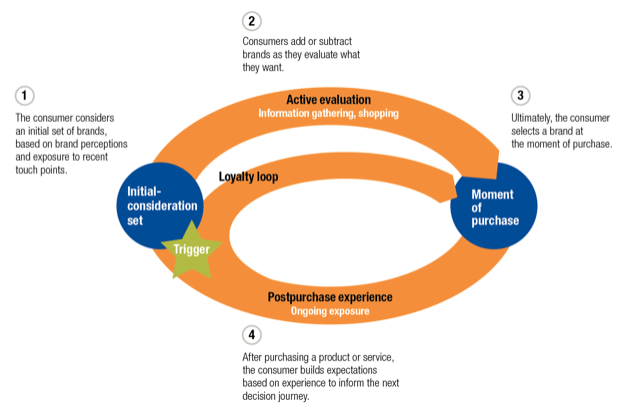Recently, Intermarché, a French supermarket chain, announced that it would change the recipes of some 900 products after they received poor scores from Yuka, a mobile application that scans and scores food and cosmetic products based on their nutritional quality enabling consumers to make more informed purchases.
What is significant about this story is that demonstrates the key role that smartphones play in influencing consumers' purchasing decisions.
What is the Consumer Decision Journey?
The consumer decision journey refers to typical customer activities that lead to the purchase of a product or service. During the consumer decision journey, customers pass through several stages as they move closer to making a purchase.
 Image: Illustration of the consumer decision journey as defined by McKinsey & Company.
Image: Illustration of the consumer decision journey as defined by McKinsey & Company.
The Effect on the Consumer Decision Journey
The smartphone is not everything, but it is pretty damn important as consumers’ go-to device for researching product information, comparing prices, searching for store locations, etc.
Recent studies have highlighted the growing influence of smartphones on the consumer decision journey and customer experience within the retail industry. One study pointed out that nearly 60% of shoppers use their smartphones to look up product information and prices while shopping in brick-and-mortar stores.
Download our white paper: The Digital Trends and Challenges in Retail
Equally impressive perhaps is the rising influence of digital channels that now affect more than half of in-store sales or 56 cents of every dollar spent in-store.
Also striking is the significant percentage of consumers who prefer to find product information using their smartphone than by consulting a store employee.
According to an international consumer survey, 66% of shoppers prefer to obtain product information via their mobile phone instead of asking a sales associate.
Meeting the evolving needs and behaviors of consumers is extremely important for retailers. Retailers and brands must, therefore, rethink their mobile strategies to ensure they offer high-quality digital platforms that facilitate the customer’s experience from start to finish.
To help in this endeavor, we complied three points to consider to improve the overall quality of e-commerce sites and apps to better serve customers online and in-store.
3 Digital Testing Points to Optimize your Mobile Strategy
1) Test the product details page
First and foremost, the quality of a retailer’s product details page (PDP) is crucial to its success. Retailers need to ensure that the information on the PDPs is clear, accurate, and engaging.
Furthermore, retailers should take steps to validate the quality and performance of the functionalities on the PDPs and evaluate the user experience. This can be done with exploratory testing as well as scenario testing and can go a long way towards eliminating bugs, anomalies, and other flaws that can disrupt online shoppers and negatively affect key metrics like your conversion rates, customer acquisition costs, and more.
2) Cross-device testing
Online shopping is largely a cross-device activity. Slightly more than 80% of consumers shop online using a smartphone or tablet as one of their online shopping devices.
In addition, smartphones and tablets as mobile devices are responsible for 59% of retail website traffic. Nonetheless, desktops make up 66% of all online retail sales.
What is key to take into account here is the role smartphones play in the user experience and customer journey. Second, given the cross-device nature of shopping, it is important for retailers to execute cross-device tests. Testing apps and websites across a variety of devices and configurations (brand/model/OS version/screen size) can help brands uncover bugs that can be contributed due to fragmentation.
3) Load testing
Driving tons of traffic to your website or app is great. However, like anything in life, having too much of something can spell trouble. In the retail industry, it is absolutely necessary for companies to load test their apps and sites to determine how much traffic can be supported before speed, performance stability are compromised.
Every year, major retail websites and apps experience significant problems caused by a surge in traffic. When this happens, shoppers can be run into numerous problems from slow and unresponsive pages, blocked functions, or even a complete crash of the site or app. These technical difficulties not only annoy customers but also prevent them from placing orders or getting valuable product information they needed to make an in-store purchase.
To avoid this fate, retailers should carry out load tests to uncover any issues that can cause problems and hinder the performance of their websites or applications during busy shopping periods.
To learn more about the importance of quality assurance testing for retail websites, please do not hesitate to download our latest white paper: "The Challenges of Testing E-Commerce Sites."








